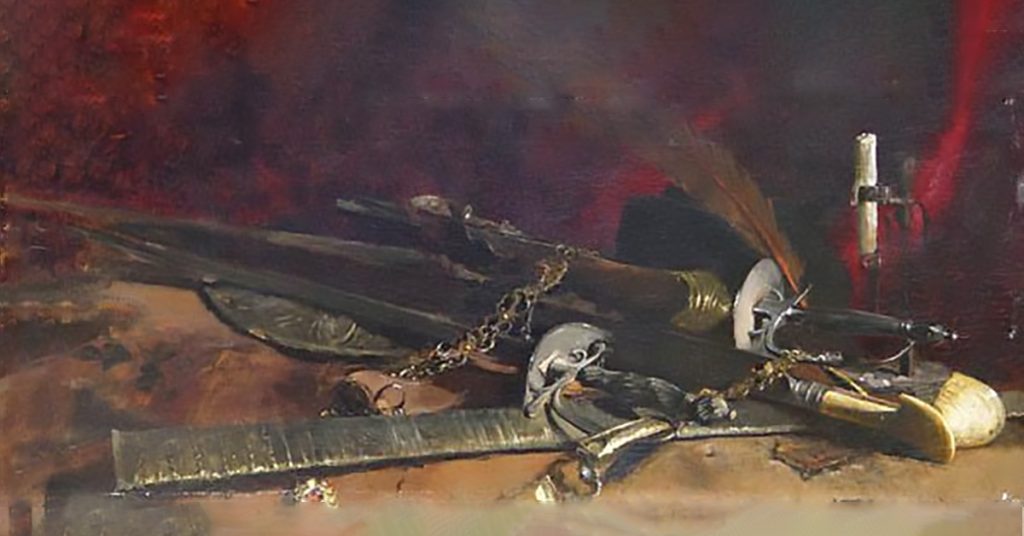Back to Melee Weapon Search
Sword, shamshir / saif
Sword, Blade, Sidearm, Cavalry, Persia, Military, Civilian, Middle East, Central Asia, Africa, Saber
Aka ‘Scimetar’. The word "shamshir" means 'curved like a tigers tail', this was the name made for an acutely curved saber used in Persia, curving up to 15 degrees from cross to tip. Sabers were adopted fairly late in Central Asia and the Middle East, but were becoming widespread by the 16th Century when this unique design began to appear. A typical Shamshir had a simple crossguard up to 2” wide on each side, and was carried horizontally with the hilt and tip pointing up.
The shamshir has many cousins in the region, all of which appeared around the same time and all of which were probably copies of the Persian shamshir (or possibly the Chinese dao). The Arab saif, the Etheopian guardes, and the Turkish killij all closely resemble the shamshir. All of these weapons were similar: slim cavalry sabers with deeply curved slicing blades designed for draw-cutting, featuring a small, canted grip intended to aid in weapon retention.
 Arab Shamshir, 16th C
Arab Shamshir, 16th C  A Persian Shamshir, 17th Century, gold hilt with gilded wootz steel blade. Due to the acute curve this is a 2/6/3 weapon. D8 damage, Hardness 12, Ehren +8
A Persian Shamshir, 17th Century, gold hilt with gilded wootz steel blade. Due to the acute curve this is a 2/6/3 weapon. D8 damage, Hardness 12, Ehren +8  Military Shamshir, Ottoman, 19th Century
Military Shamshir, Ottoman, 19th Century  Persian Shamshir, 16th Century, ivory hilt and wootz steel blade. Due to it’s length, this is a 3/5/3 weapon. Because of the wootz metal, this weapon will do D8 damage, and has Hardness 12, and Ehren
Persian Shamshir, 16th Century, ivory hilt and wootz steel blade. Due to it’s length, this is a 3/5/3 weapon. Because of the wootz metal, this weapon will do D8 damage, and has Hardness 12, and Ehren  Abyssinian Shotel Saber, Ethiopia, 19th Century. Due to the acute curve and very sharp point this would be a 2/6/3 weapon with S/P Primary attack types.
Abyssinian Shotel Saber, Ethiopia, 19th Century. Due to the acute curve and very sharp point this would be a 2/6/3 weapon with S/P Primary attack types.
| Name | Size | Reach | Speed | Defense | Base Damage | Attack Types | Primary Attack Types | Armor Pierce | Grapple | Hardness | HP |
|---|---|---|---|---|---|---|---|---|---|---|---|
| Sword, shamshir / saif | M | 2 | 5 | 3 | 1-6 | SCP | S | 0 | 0 | 10 | 3 |
 Arab Shamshir, 16th C
Arab Shamshir, 16th C  A Persian Shamshir, 17th Century, gold hilt with gilded wootz steel blade. Due to the acute curve this is a 2/6/3 weapon. D8 damage, Hardness 12, Ehren +8
A Persian Shamshir, 17th Century, gold hilt with gilded wootz steel blade. Due to the acute curve this is a 2/6/3 weapon. D8 damage, Hardness 12, Ehren +8  Military Shamshir, Ottoman, 19th Century
Military Shamshir, Ottoman, 19th Century  Persian Shamshir, 16th Century, ivory hilt and wootz steel blade. Due to it’s length, this is a 3/5/3 weapon. Because of the wootz metal, this weapon will do D8 damage, and has Hardness 12, and Ehren
Persian Shamshir, 16th Century, ivory hilt and wootz steel blade. Due to it’s length, this is a 3/5/3 weapon. Because of the wootz metal, this weapon will do D8 damage, and has Hardness 12, and Ehren  Abyssinian Shotel Saber, Ethiopia, 19th Century. Due to the acute curve and very sharp point this would be a 2/6/3 weapon with S/P Primary attack types.
Abyssinian Shotel Saber, Ethiopia, 19th Century. Due to the acute curve and very sharp point this would be a 2/6/3 weapon with S/P Primary attack types.
